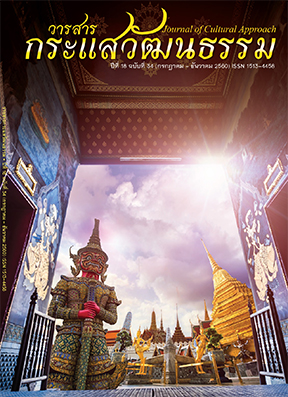The Study of Mon Culture and Natural Resource Conservation of Mon Village for Sustainable Community-Based Tourism in Sangkhlaburi, Kanjanaburi Province
Main Article Content
Abstract
This research aims to study the relation between Mon culture and tourism management and to study the participation of Mons to natural resource conservation in Sangkhlaburi, Kanchanaburi province. The tool of this project is observation and semi-structured interview. The sample group consists of 30 respondents who are a group of people who provide information leading to the group's knowledge and observers including local community participating in tourism management in Sangkhlaburi by using purposive sampling. Moreover, all samples have to live in Sangkhlaburi more than 10 years.
The result found that nowadays the cultural identity of Mons is fantastic attraction and become the most important tourism product of Sangkhlaburi. The Mons participate in ethnic tourism management as labor and souvenir producer. However, accommodation business and services are managed by Thais who are entitled to earn a living by legal right in the country. As for the participation in natural resource conservation of Mons, the main issue is legalization and human right especially ethnic groups in Thailand. The level of participation of Mons whether or not they play a role in tourism management or natural resource conservation is very low. The diaspora Mons have only right to make a living as a workforce or an employee. Furthermore, they cannot play a significance role in a commentator or an operator of natural resource conservation in Sangkhlaburi.
Article Details
Proposed Creative Commons Copyright Notices
1. Proposed Policy for Journals That Offer Open Access
Authors who publish with this journal agree to the following terms:
- Authors retain copyright and grant the journal right of first publication with the work simultaneously licensed under a Creative Commons Attribution License that allows others to share the work with an acknowledgement of the work's authorship and initial publication in this journal.
- Authors are able to enter into separate, additional contractual arrangements for the non-exclusive distribution of the journal's published version of the work (e.g., post it to an institutional repository or publish it in a book), with an acknowledgement of its initial publication in this journal.
- Authors are permitted and encouraged to post their work online (e.g., in institutional repositories or on their website) prior to and during the submission process, as it can lead to productive exchanges, as well as earlier and greater citation of published work (See The Effect of Open Access).
Proposed Policy for Journals That Offer Delayed Open Access
Authors who publish with this journal agree to the following terms:
- Authors retain copyright and grant the journal right of first publication, with the work [SPECIFY PERIOD OF TIME] after publication simultaneously licensed under a Creative Commons Attribution License that allows others to share the work with an acknowledgement of the work's authorship and initial publication in this journal.
- Authors are able to enter into separate, additional contractual arrangements for the non-exclusive distribution of the journal's published version of the work (e.g., post it to an institutional repository or publish it in a book), with an acknowledgement of its initial publication in this journal.
- Authors are permitted and encouraged to post their work online (e.g., in institutional repositories or on their website) prior to and during the submission process, as it can lead to productive exchanges, as well as earlier and greater citation of published work (See The Effect of Open Access).
References
[2] Department of Social Development and Welfare. (2016). Ethnic Groups in Thailand, According to the Settlement. Office of Ethnic Affairs. Retrieved October 1, 2016, from https://www.chatipan.dsdw.go.th/chatipan02.html.
[3] Kaewkhunok, Suppawit. (2009). Tourism and the Commodification of Mon Culture at Sangkhlaburi. Retrieved October 29, 2016, from https://www.academia.edu/ 20323980.pdf.
[4] Meesomklin, Tanyapa., Chantasuriwong, Rattaphum., Limratanametha, Bariwat., & Kaewkhunok, Suppawit. (2015). Mon-Sangkhla: Becoming a Tourist Hotspot of Kanchaburi Province. The 8th Thai Student Symposium on Geography and Geo-informatics, 25-26 December 2015.
[5] Prasitthisarn, Tananset., Kaitpraneet, San., & Huamuangkaew, Wuttipol. (2013). People Participation in Forest Resource Conservation at Pa Phu Ra-hgum National Reserved Forest, Waeng Yai and Connabot District, Khon Kaen Province. Thai Journal of Foresty, 33(1), 57-65.
[6] Renard, R., & Singhanetra-Renard, Ancharee. (2015). Mon and Khmer: Peoples of the Mekong Region. Chiang Mai University Press.
[7] Sangchawee, Siriwat., Jintana, Vipak., and Pipatnawatanakul, Damrong. (2013). People Satisfaction on the Headwaters’s Community Development in Nong Lu Sub-district, Sangkhla Buri District, Kanchaburi Province. Thai Journal of Foresty, 32(2), 204-213.
[8] Tabwiset, Apichat. (2003). Luang Por Uttama: Culture Hero and the Social and Cultural Change of Diaspora Mon Village in Sangkhlaburi. Graduate School, Silpakorn University.
[9] Yamcharoen, Nattapong. (2014). From Utamanusorn Wooden Bridge to Bamboo Floating Bridge: Reflection of Life on the Changing of Thai and Mon besides the Songalia River. Kasem Bundit Journal, 15(2), 89-102.


